 There are many cynics out there that critique and question the future of sustainable products and businesses. It’s easy to side with them, mostly because it’s difficult to understand what comprises a “sustainable” product which in turn creates a domino chain of skepticism about achievability. We don’t endorse what we don’t understand. The industry is in self-defining mode and most of us lack the degrees in chemistry, biology, natural sciences or any other course of study that might support our inclination to trust what marketers tell us is “safe” and what is not.
There are many cynics out there that critique and question the future of sustainable products and businesses. It’s easy to side with them, mostly because it’s difficult to understand what comprises a “sustainable” product which in turn creates a domino chain of skepticism about achievability. We don’t endorse what we don’t understand. The industry is in self-defining mode and most of us lack the degrees in chemistry, biology, natural sciences or any other course of study that might support our inclination to trust what marketers tell us is “safe” and what is not.
Part of the difficulty is that in fact, sustainability is very conceptual. The notion of sustainability infers something of a philosophical state where we are presented with daily choices that will make our planet a better place. We’ll be healthier, our children will be safer and the world will last a little longer. The reality and inherent challenge is that we’ve created a world where these ideas have no grounding in the mechanics of our daily lives.
This does not mean however that “sustainability” is a passing fancy. As we slug out of a contracting economy and slowly move towards incremental expansion, it’s important to understand how the mechanisms of a sustainable economy are taking hold, who is driving this and how brands have an opportunity to play a leading role in driving the momentum.
A sustainable world will not be an over night phenomenon. In fact I would argue a sea change is taking place but we have barely begun to see the ripples. With a new administration, government has demonstrated that they will be playing an instrumental role on the compliance and technology side. The stimulus package contained a $6 billion dollar loan-guarantee program for alternative energy investments, a $4.5 billion green-building conversion effort and money for smart grid technologies. The Blue-Green Alliance, a joint venture of unions and environmentalists, projects nearly one million of current manufacturing jobs will be converted to green jobs. And the appointment of Van Jones, founder of Green For All, as President Obama’s Special Advisor for Green Jobs, Enterprise and Innovation at the White House Council on Environmental Quality underscores how committed government is to sustainable innovation in business operations.
Investment and skilled leadership are critical but bills and legislation will also be necessary to activate marketplace behavior. Bills such as the recent Cash for Clunkers program serve as seeds for a marketplace response while incentivizing functional behavior change among populations that need practical adoption mechanisms. Policy-discussions on carbon emissions later this year will also serve as a business driver. Whether it’s a carbon tax, a cap n’ trade approach or a blended approach, there is little doubt that a regulated response to environmental damage is necessary.
As government begins to navigate the waters driving compliance, business is only just beginning to wade through both the semantics and back-end infrastructure associated with lesser impact and responsible production. A few companies, and even some brand leaders, have come forth and mandated initiatives encompassing operations and employee programs that will fundamentally shift thinking. A few have begun to market products that make claims of natural, re-claimed, re-cycled, organic or bio-compostable. Store shelves are slowly becoming populated with concentrated dish liquid (less water impacting the entire product to shelf delivery chain), dryer sheets containing biodegradable softening agents, petroleum-free softeners, and 100% recycled paperboard.
Ingredient and manufacturing education covers just one side of the product’s life cycle. Consumer usage education is another important component. Where should we safely dispose of our batteries or our newly purchase CFL’s? What should we do with our old TV set as we go HD? Should we donate our old clothes or trade them in for discounted versions so that our old garments get “recycled”. In the old economy of consumption, these were seldom asked questions. But our new economy requires a cooperation and a more thoughtful end-to-end infrastructure of solutions. And while this is seemingly counter-intuitive to a culture of simple disposal, these new behaviors are actually golden opportunities for a business to cement relationships with their customers.
This is where brands come in. Brands are thought leaders. Brands hold consumer trust. And brands live and breathe in our dynamic culture. We have a unique symbiotic relationship with brands in that we both need each other – we desire them as much as they need us.. We walk a fine line together of needing to keep things the same while also looking for change and “improvement”. It’s in this economy that brands can uniquely guide us into making sense of what is happening. They can educate and entertain us while providing the comfort that our needs will still be fulfilled. They can chaperone us down altered usage paths in a way that no one else can.
Regardless of whether the adjective “sustainable” plays out as a defining characteristic of a product or service, the notion of responsible consumerism will continue to pervade our daily lives as our natural resources are depleted, our dumps fill, our skies become clouded and as we become more self-aware of what is “good” for us. Brands have a tremendous opportunity to be innovative leaders here. Some of the usual suspects have already started to lead the pact. The question is, which new ones will be brave enough to meet the challenges and set new standards?
image credit: dictionary of image creative commons


